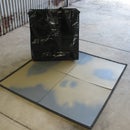Introduction: Stand for Freetronics Dot Matrix Display
I had bought a couple of the Freetronics Dot Matrix Displays (DMD) last year but found them unwieldy when trying to use them. It wasn't a problem with programming the Arduino for the DMD. It was their physical size on my desk and that they were always face down, I was worried that something might short out when they were face up. That and the short cable to the Arduino. This was even worse when you tried to chain two together.
I recently joined Hackerspace Adelaide. Hackerspace had a stall at the Science Alive show and I wanted to create some displays for the stall using my DMDs and the one from Hackerspace. Again there was the problem of how to make a neat display.
I made and donated 2 of the latest designed stands to Hackerspace.
Enter FabLab Adelaide. They have couple of laser cutters and several 3D printers, as well as other equipment. One of the laser cutters is an Epilog Mini. Great, I could now create some stands for the DMDs.
Thanks to the people at FabLab for all their help with laser cutting.
Step 1: Design It and Cut It.
I designed the stand using Corel Draw and then laser cut it at Fab Lab. I went through a few interations, of course. I used the Epilog to cut out some 3mm clear acrylic sheets.
The idea of the stand was to have the DMD mounted on the front and have a place on the back to mount an Arduino Uno. The strange arrangement of holes between the access holes and support slots are the Arduino Uno mounting holes. There are four sets of mounting holes so the Arduino an be mounted facing up, down, left, or right. and it can be mounted on the left hand or right hand side. Though I guess that it will be always be on the left (looking from the back).
Step 2: Tap Some Holes
Next was to tap the holes along the edges of the frame. The holes are tapped to accept M4 screws. The screws will hold the joining plates to the frames. I may of over engineered that part with too many screws, but you don't have to use them all.
I enlarged the holes with a 3.5mm drill. I haven't got the hang of cutting precise hole sizes, so I make them smaller and dill them out to size later. I then hand tapped the holes with a M4 (4 x 0.7mm).
Notice the fancy tap guide to make sure the tap is 90 degrees to the plastic. It's just a scrap of laminated chip board with a 4mm hole drilled through it on a calibrated drill press. The other side has been drilled half way, slightly larger to allow for the tap's shank.
Step 3: Put It All Together
Firstly check that the support pieces fit firmly when pushed along the slots, so the supports won't fall out every time you lift the DMD and frame. I had to shim the gap placing some self-adhesive plastic strips on the plastic plate.
I mounted some M3 nylon tapped spacers for the Arduino on the acrylic plate. Used M3 x 6mm metal screws through the plate. I then screwed some M3 x 15mm metal spacers onto the mounting screws of the DMD. Then the plate is screwed on to the spacers using M3 x 10mm screws.
The joiners can be screwed on if needed.
Step 4: Mounting the Arduino
I mounted the Arduino with some nylon M3 x 6mm screws. Connect the DMD to the Arduino and it's all ready to go.
You can connect two or more DMDs together in a row (I need a new design for columns). Just use the joining plates. In fact you can double up the joining plates for more strength.
Step 5: Future Improvements?
The design of the supports needs to be improved. I don't like having to shim the support. I'm worried that if you shim too much the "hook" of the support can crack and then break. Maybe a living hinge/spring design.
I've also had a support crack and break on a sharp internal corner. I need to remove sharp corners or have stress relief holes.
A stand that can be joined vertically as well as horizontally.
Any other suggestions?

Participated in the
Microcontroller Contest

Participated in the
Epilog Challenge VI













